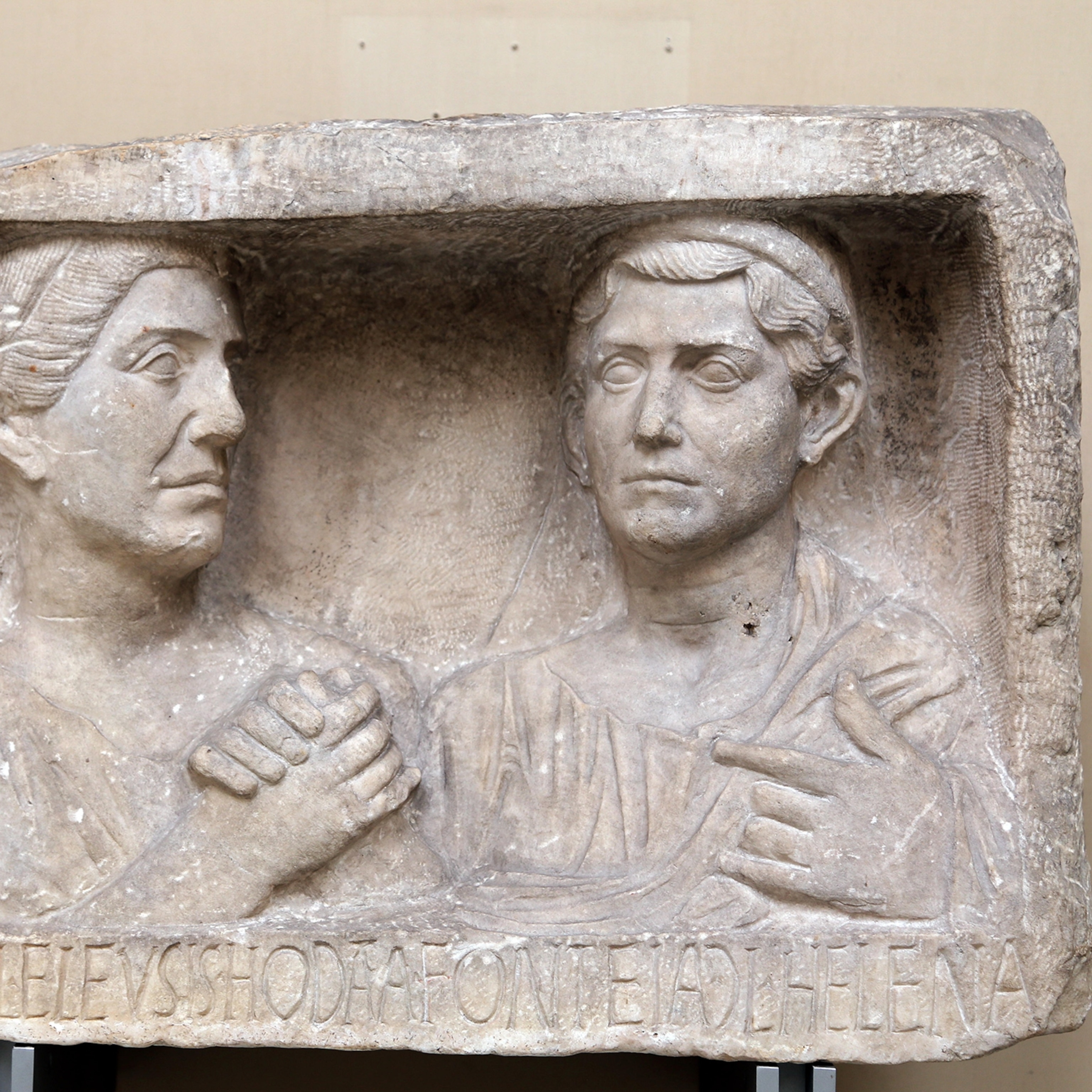
The Colossus of Rhodes, the bronze wonder of the ancient world
Standing for a little more than 50 years in the third century B.C., Rhodes’s titanic statue of Helios made a colossal impact on Western art, history, and imagination.
The Greek poet Antipater of Sidon, writing in the second century B.C., is often attributed with compiling the Seven Wonders of the Ancient World. These outstanding monuments and feats of engineering were referred to in Greek as themata, or things to be seen, similar to today’s must-see lists in travel guides. (See also: Standing tall: Egypt's Great Pyramids.)
Earthquakes, fire, war, theft, and the relentless ruin of time, have left the world with just one of Antipater’s recommendations, the Pyramids at Giza. Although the Pharos of Alexandria, the Statue of Zeus at Olympia, the Temple of Artemis at Ephesus, and the Mausoleum at Halicarnassus have fallen into ruin, archaeology and historical accounts provide some idea of their appearance. Not so with the Colossus.

Like the Hanging Gardens of Babylon (which some say never existed), the exact appearance of the Colossus that towered over the port of Rhodes is a mystery. Toppled by an earthquake around 225 B.C., the massive statue stood for a little more than 50 years. Historians have very little information as to what the structure looked like, where it stood, and how it was built. This vacuum has filled with much speculation and artistic license, but certain clues have helped researchers piece together credible theories about this marvelous structure.
Colossal Siege
Luckily for historians, why the Colossus was built is easily found in the historical record. First-century B.C. historian Diodorus Siculus recorded the fourth-century B.C. conflict known as the siege of Rhodes.
In 408 B.C. three city-states on the Mediterranean island of Rhodes (Lindos, Kameiros, and Ialysos) banded together to build a new federal capital and port. The city, also called Rhodes, grew prosperous through trade and built up strong commercial and diplomatic relationships with other Mediterranean powers.
Goods and Gods
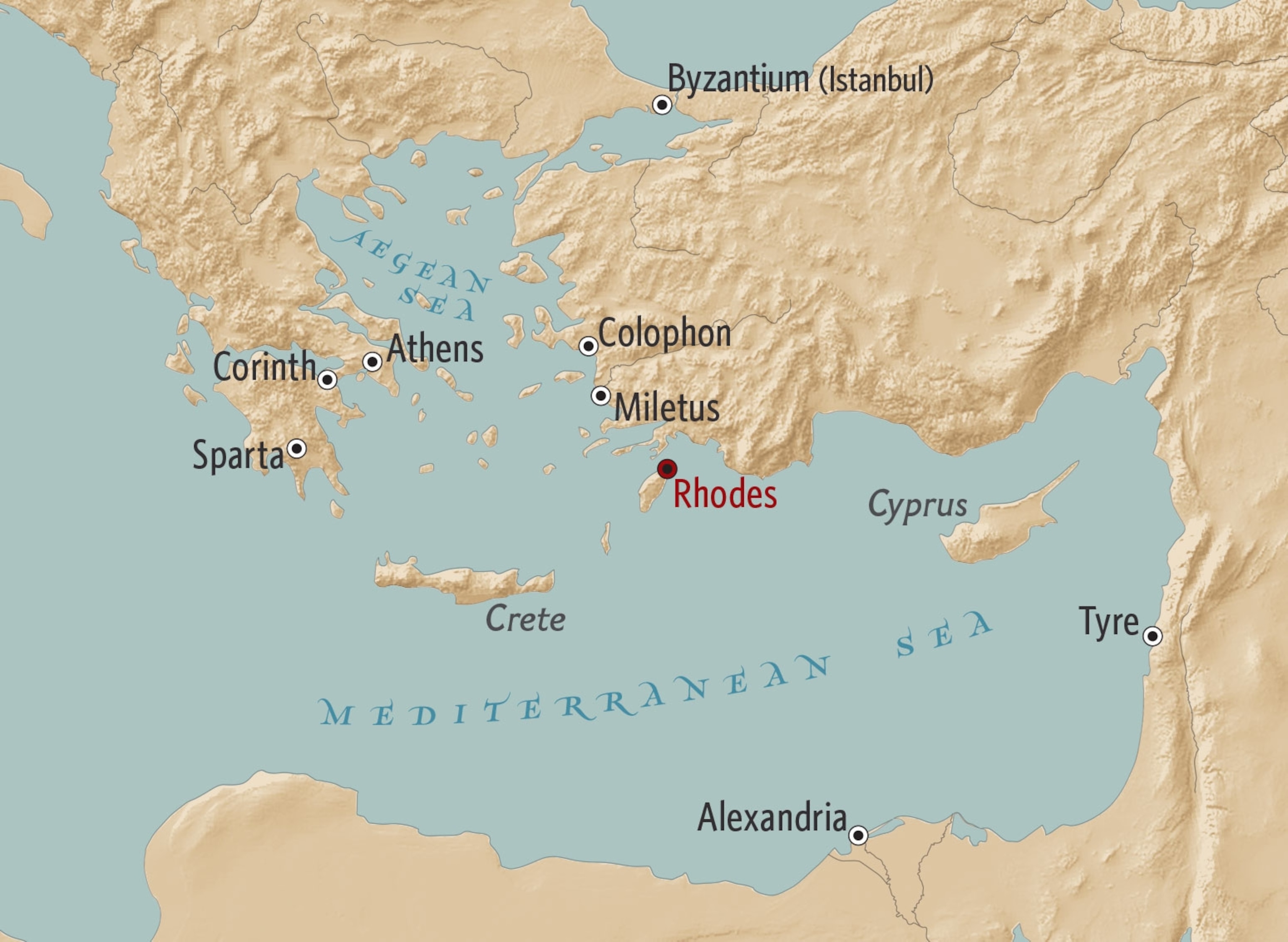
Rhodes lies along the southeastern rim of the Aegean Islands. Its port, also named Rhodes, is located on the northern tip. At the time the Colossus was built, the port was an important stop on the trade routes linking Greek cities in Asia Minor—such as Miletus—with the wealth of Egypt, ruled by the Greek Ptolemies. In the third century B.C. Rhodes had close links with Alexandria, founded a century before by Alexander the Great. ssociated with the Egyptian god Ra, Helios was also an important deity there.
At the end of the fourth century B.C. war broke out between two of Alexander the Great’s successors: Ptolemy I, king of Egypt, and Macedonia’s king Antigonus I (called Antigonus Cyclops for only having one eye). Formidable sailors and skilled diplomats, the Rhodians would not renounce their ties with the Egyptians. Antigonus did his utmost to persuade them to take his side, and when they refused, he decided to use force.

Antigonus sent his son Demetrius to subdue Rhodes in 305 B.C. After several failed attempts to capture the city, Demetrius ordered the construction of a Helepolis (“taker of cities”), a wheeled siege tower that may have stood more than 100 feet tall. Protected by metal plates and armed with catapults, this fearsome weapon failed to bring victory to Demetrius. Rhodes stood strong, and Demetrius withdrew after an unsuccessful, yearlong siege. Rhodes and Macedonia agreed that the Rhodians would back Antigonus against his enemies except Ptolemy. In exchange, they would remain politically and economically autonomous.
Colossal Rise
In gratitude for withstanding the siege, the inhabitants of Rhodes decided to build an extraordinary statue in honor of Helios. In Greek mythology, Helios was one of the Titans, the gods who ruled over Greece before the Olympians. Lord of the sun, Helios drove his chariot across the sky each day. The island of Rhodes was sacred to him, and he its patron deity.
To build the massive statue, Rhodes needed bronze, and a lot of it. A treatise entitled On the Seven Wonders of the World, attributed to second-century B.C. engineer Philo of Byzantium, explains that the statue required 12 to 13 tons of bronze, “an operation that involved the bronze industry of the entire world.” Sources say that some bronze was scavenged from the abandoned Helepolis, and the rest was purchased with money raised by selling the weapons and armor left behind by Demetrius.
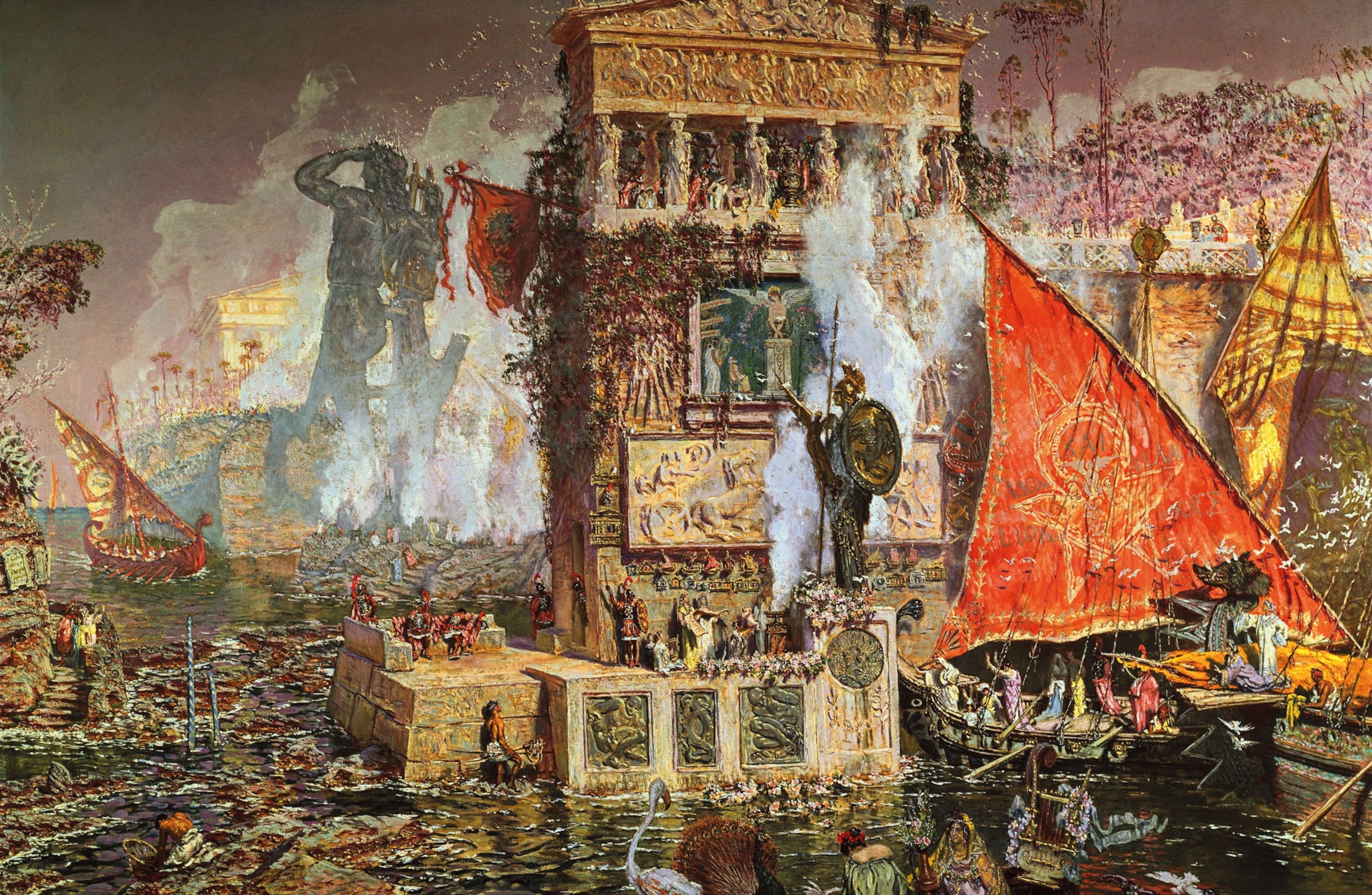
Chares of Lindos, a Rhodian sculptor, was commissioned to construct the monument. Respected across the Greek world, he was a pupil of the famous sculptor Lysippus, a favorite artist of Alexander the Great. As an offering to Rhodes’s most important divinity, the new statue had to measure up to what it represented—the Rhodians’ victory and the god who made it possible. Chares may have conceived his commission with a great statue of Zeus in mind: Sculpted by Phidias for the temple of Zeus at Olympia, this statue was massive, described as being seven times larger than life.
Working from 294 to 282 B.C., Chares took 12 years to erect the Colossus. Many questions remain as to what exact methods he employed to build it. Philo’s treatise proposes that it was cast in a customized way, different from most statues: It was built in situ, piece by piece. Work began at the bottom, and the feet were put in place first. Philo wrote: “The artist heaped up a huge mound of earth round each section as soon as it was completed, thus burying the finished work under the accumulated earth, and carrying out the casting of the next part on the level.” Then the statue rose like a building as each new section was attached to the one beneath it. However, Philo was writing more than 100 years after the Colossus had been built. Modern art historians do not know what sources he relied on to gather his information, and many dispute the methodology described in his text.
The principal ancient source for the Colossus’ dimensions is Pliny the Elder’s first-century A.D. work, Natural History. Writing some 200 years after the Colossus was built, Pliny stokes the sense of wonder that had caused the Colossus to be included in the list of themata: “That [large statue] which is by far the most worthy of our admiration, is the colossal statue of the Sun, which stood formerly at Rhodes, and was the work of Chares the Lindian.” Pliny’s account puts the statue at “70 cubits”—around 108 to 110 feet (the exact dimensions of Greek cubits varied somewhat from place to place).
The statue was so big that in Pliny’s words, “Few men can clasp the thumb in their arms, and its fingers are larger than most statues.” Strabo, a near contemporary of Pliny’s, also wrote of the structure in his Geography. Despite marveling at its size, however, neither source describes what it looked like and where exactly it stood in the port city, omissions that have frustrated historians ever since.
What is indisputable is that the Colossus was magnificent. An excerpt from a poem of the time testifies, “To you, o Sun, the people of Dorian Rhodes set up this bronze statue reaching to Olympus, when they had pacified the waves of war and crowned their city with the spoils taken from the enemy.”
Colossal Fall
The Colossus, Chares’s audacious “second sun,” was not destined to last for centuries: An earthquake destroyed it and parts of the city of Rhodes in 226 or 225 B.C., little more than half a century later. Most sources agree that when the statue fractured, it broke at the knees.
Although Ptolemy III Euergetes of Egypt offered funds and labor to rebuild it, Strabo tells us the Rhodians did not dare to do so as an oracle advised them against it, so the pieces were left where they fell. Ptolemy’s interest in the Colossus reveals the close links between Rhodes and Egypt, and the awe with which the figure of Helios was regarded in the region. Ptolemy III even represented himself as Helios on a coin, wearing a crown denoting rays of the sun.
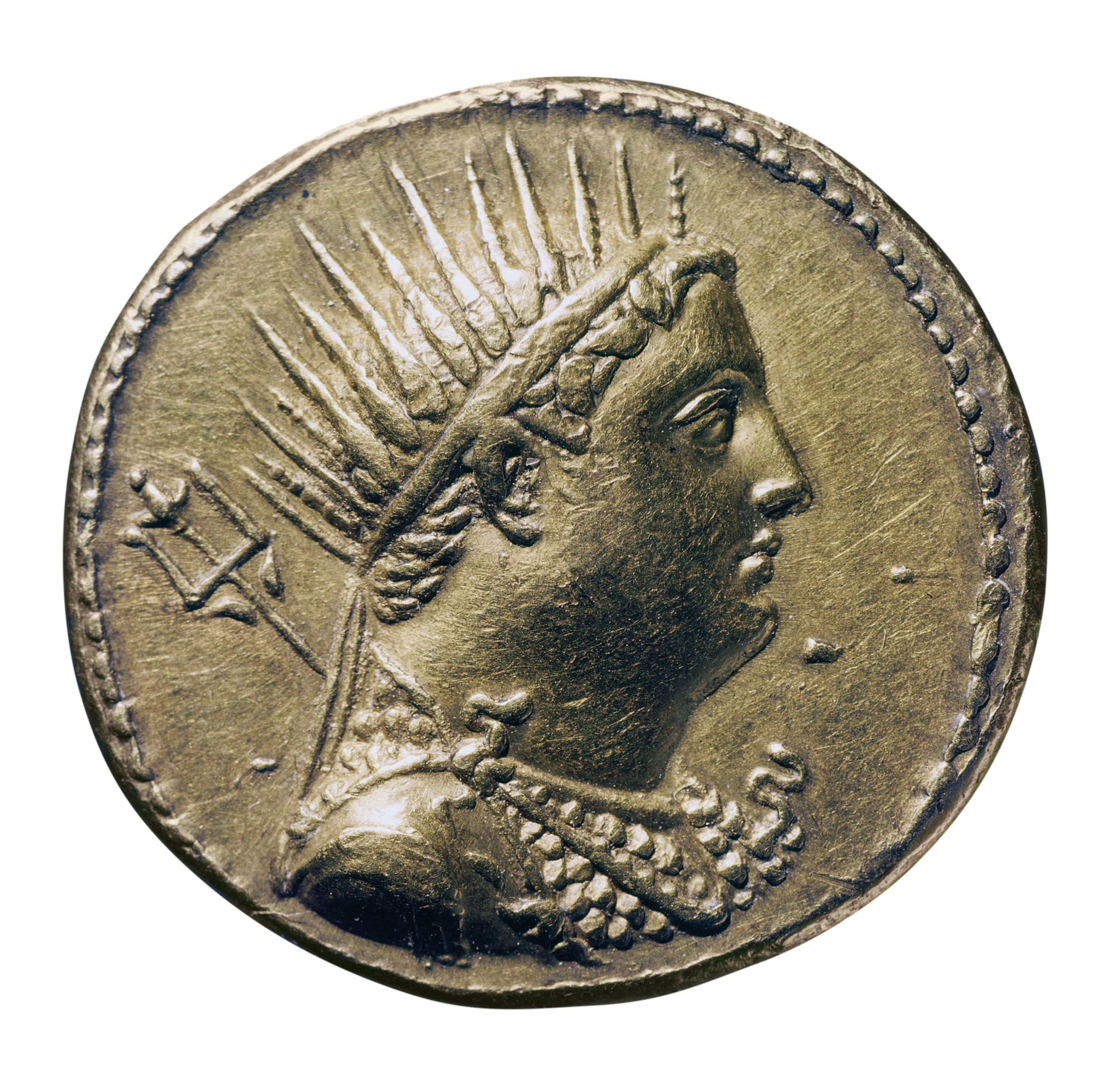
Lying on the ground, the vast remains of this giant were admired for centuries. Even as the Colossus lay shattered, Pliny the Elder noted that it was still a “marvel.” Its dismantled state allowed spectators to peer inside, where “are to be seen large masses of rock, by the weight of which the artist steadied it while erecting it.” In the second century A.D. Lucian of Samosata joked that the Colossus of Rhodes, just like the Pharos of Alexandria, could be seen from the moon.
Time eventually ran out for travelers wishing to admire what remained of the great figure of Helios, even in its fallen state. By the middle of the seventh century, the Umayyad Muslims captured much of the eastern Mediterranean. When their general and future caliph, Muawiyah, conquered Rhodes in A.D. 654, he completed the demolition of the structure. His forces collected the bronze and sent it to Syria, where it was purchased by a scrap merchant. According to Byzantine sources, more than 900 camels were needed to carry it all away.
Casting doubt
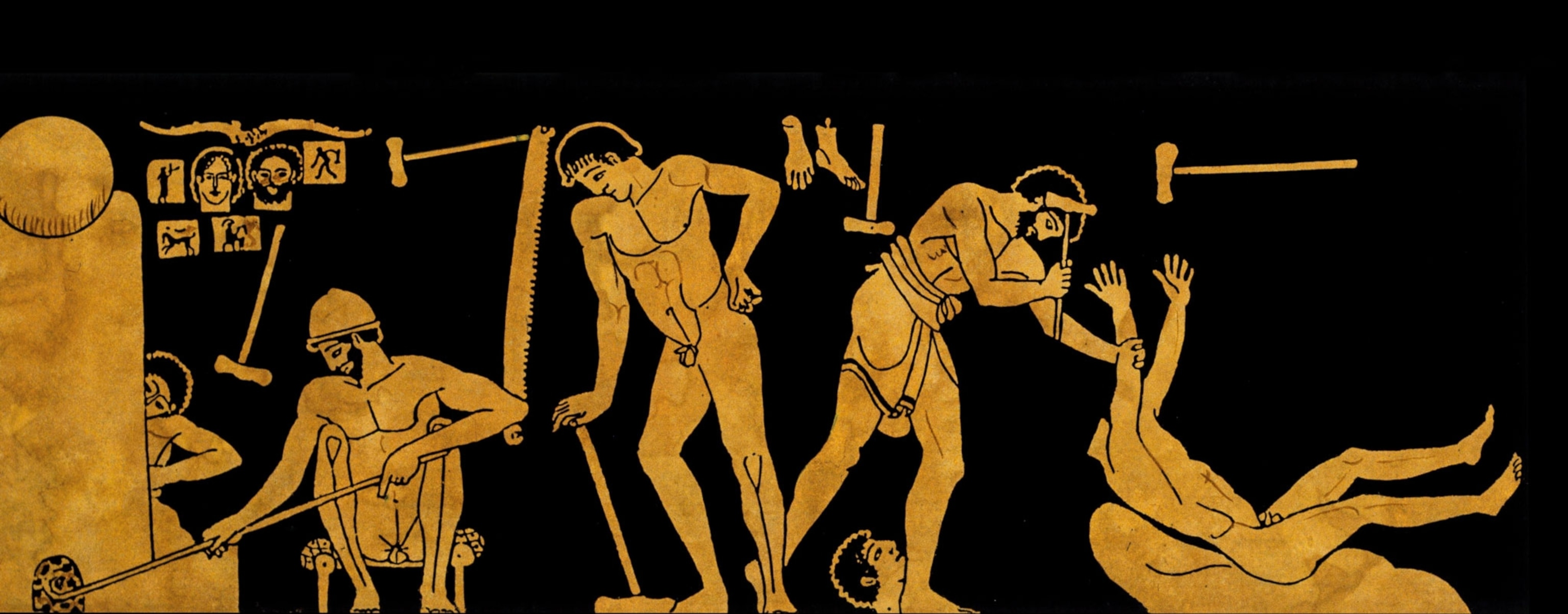
During the third millennium B.C. , the advantages of using bronze in sculpture became evident and gave rise to a long tradition of Greek bronze sculpture. An alloy made of 90 percent copper and 10 percent tin, bronze was easier to cast and stronger than pure copper. Early Greek bronze statues were simple designs made by separately hammering sheets of the metal into shape and riveting them to one another. By the fifth century B.C. lost wax casting had become the favored method. Bronze-smiths, like those depicted on this fifth-century B.C. vase, often employed differing techniques depending on the type of sculpture. Judging from the six casting pits that have been found in Rhodes, the island was an impor- tant center for bronze working in the ancient world. Even so, art historians still do not have a conclusive answer as to how the massive Colossus was cast or assembled.
Colossal Legacy
The Colossus was gone, but its fame lived on in memory. Where history lacked details, imagination filled them in. By the Renaissance, a new belief arose that the Colossus had straddled the port of Rhodes, as a gateway for ships, with each of its massive legs planted on the quays at the harbor entrance.
The image was turned into a literary metaphor in William Shakespeare’s Julius Caesar, written in 1599. The conspirator Cassius uses the Colossus to express his feelings against Caesar:
Why, man, he doth bestride the narrow world
Like a Colossus, and we petty men Walk under his huge legs . . .
One source of this enduring idea may be from the account of an Italian pilgrim, Nicolas de Martoni, who visited Rhodes between 1394 and 1395. He recorded what local people were saying about the Colossus: “In ancient times, there was a great wonder, a great idol, so admirably formed that it is said that it had one foot on the wharf, where the Church of Saint Nicholas stands, and the other on the end of the other wharf, where the windmills are.”
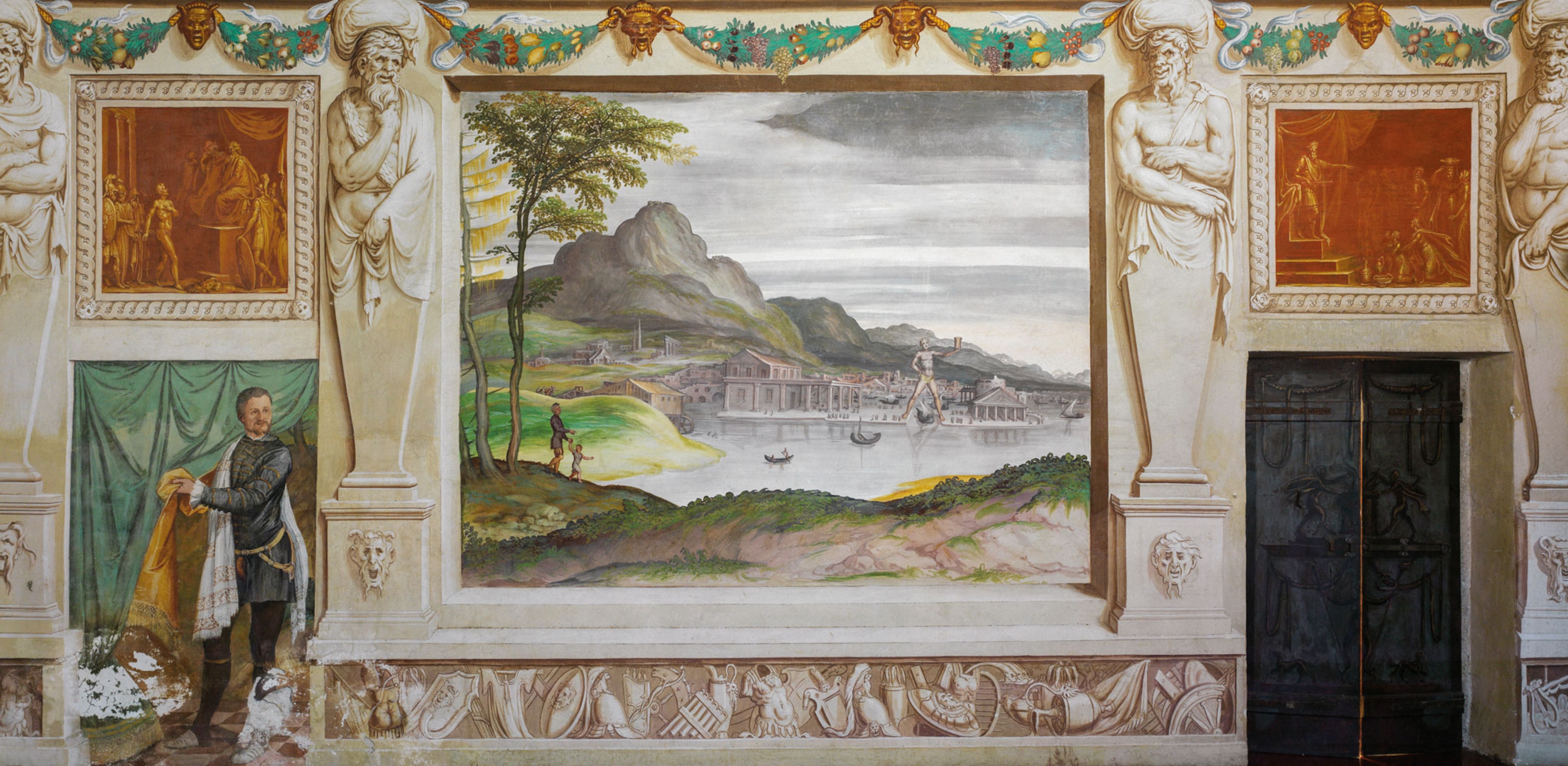
Historians now regard the idea that the Colossus stood with its legs apart as highly unlikely. It would have been physically impossible for a statue standing at least 100 feet high to be supported by legs 650 feet apart. The sculpture itself would have been too heavy for the legs to support. Scholars also point out that a wide-legged Colossus could not have withstood the strong winds of the region. The fact that many sources attest that when the earthquake struck, the Colossus broke at the knees leads art historians to believe that its legs must have been together.
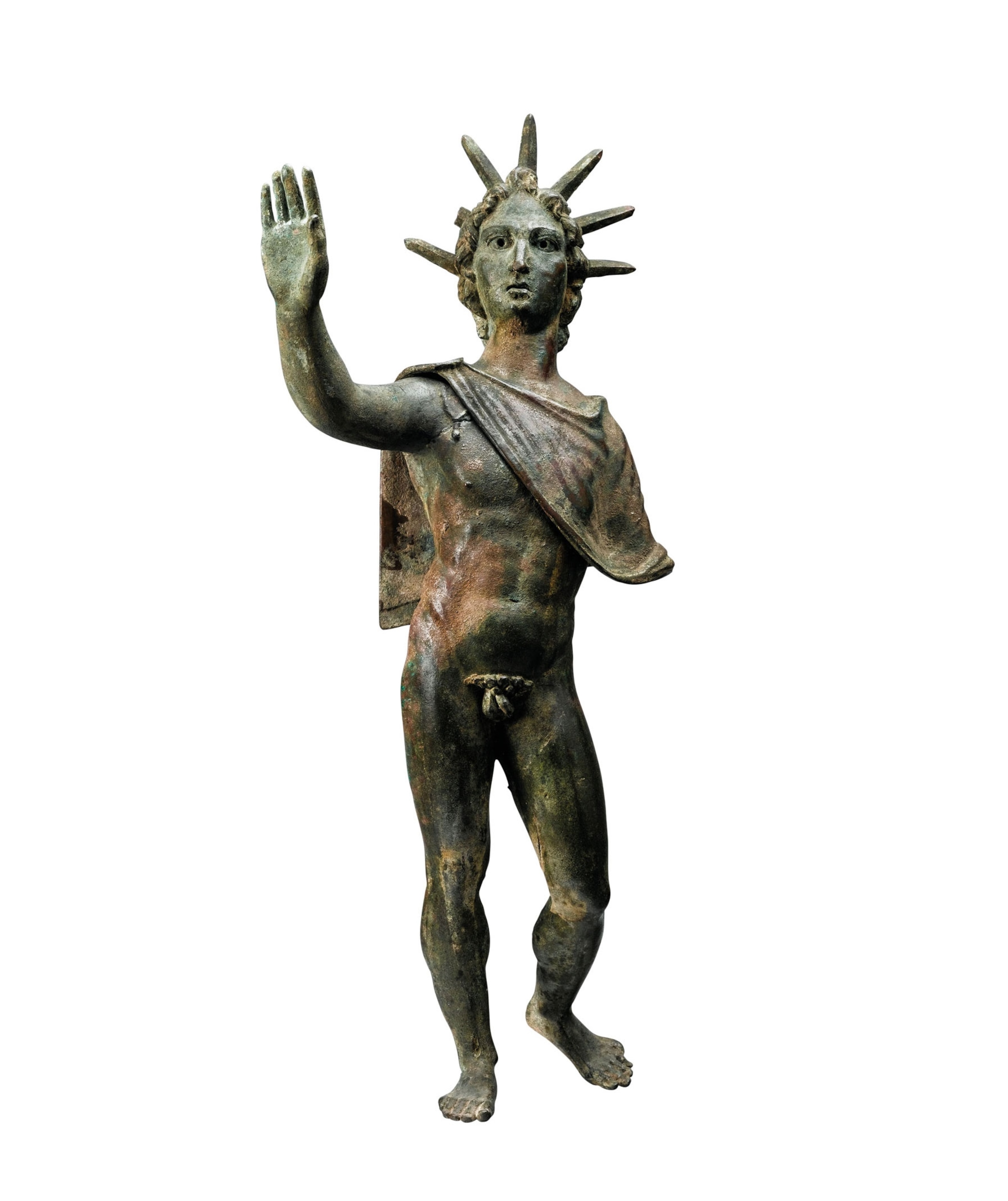
The name Colossus provides a clue as well. Originally the word did not refer to height or size—the meaning of a large statue, or the adjective colossal, are derived from the Colossus of Rhodes itself. The word was appropriated by the Greeks from the indigenous peoples of Asia Minor and referred to a special type of sculpture, none of which stood with their legs apart.
So what might the Colossus have looked like? No coins were minted with a complete rendering of it, despite the Colossus being a symbol of Rhodes’s pride in maintaining its independence. Using known depictions of Helios as a starting point, art historians believe the Colossus was probably a figure of a nude male with rays of light emanating from his head, a frequent attribute of the sun god.
Some depictions show the Colossus holding a torch, but historians believe it probably did not carry one. It has been impossible to establish what position the arms were in, whether they pointed straight downward or whether the right arm was raised as the sun god is represented in Roman statues in subsequent periods.
Most artistic representations of the statue place it at the mouth of the port, as a landmark for shipping. It is now considered unlikely to have been sited beside the sea or in the port area, however, partly due to the lack of a site big enough to accommodate it. While it is plausible that the Colossus would have been built beside a temple dedicated to Helios, no remains of a temple or an open-air sanctuary to the god have been found on the island.
A legend with legs
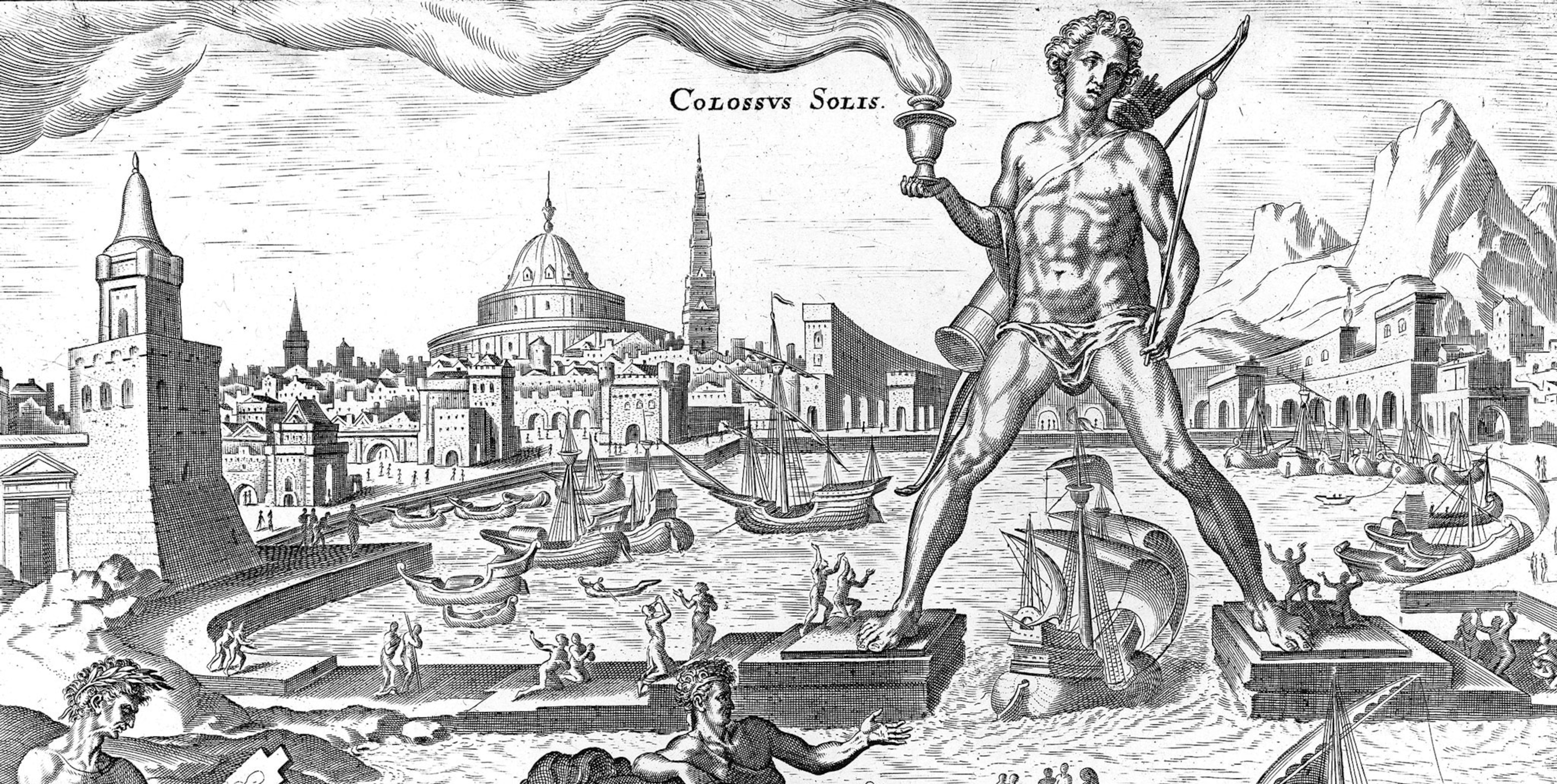
By the late 1500s spectacular but entirely erroneous ideas about the Colossus were incorporated into artistic depictions. The image of a torch-bearing figure with its legs apart was popularized farther by Dutch engravings, such as the one above, that show a ship in full sail passing beneath. These engravings reached a wide audience to become part of the iconography of this wonder of the ancient world, until it was debunked by historians in the 19th century.
Some archaeologists suggest that a sanctuary of unknown identity built near the stadium in the Acropolis at Rhodes was, in fact, dedicated to Helios. This explanation seems logical: The stadium was where athletes from all of Greece competed during the Halieia, the festival in honor of the sun god. In this case, the statue could have been cast in a nearby pit, and then raised near the spot.
The Colossus did not remain standing for long, but its legacy—even if based on misinformation—has endured, and left a deep imprint on the modern period. Its association with freedom, a torch, and a crown with solar rays, were important factors in the design of the Statue of Liberty. Its most recent contribution to visual culture is as inspiration for the giant bronze Titan statue that stands guard in the port of Braavos in George R. R. Martin’s best-selling A Song of Ice and Fire novels, the basis for the hit television series Game of Thrones.


